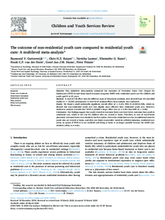Abstract
Objective
This multilevel meta-analysis compared the outcomes of Treatment Foster Care Oregon for Adolescents (TFCO-A) and home-based treatment programs (HBT) with residential youth care for children and youth aged 0 to 23 years.
Methods
A total of 145 effect sizes for different types of behavioral problems were derived from 24 controlled studies (n = 16,943 participants). A three-level random-effects meta-analysis was conducted.
Results
We found a small statistically significant overall effect (d = 0.21), 95% CI [0.090-0.338], which indicated that non-residential youth care was slightly more effective than residential youth care. However, moderator analysis revealed that TFCO-A yielded a larger effect size (d = 0.36) than HBT (d = 0.08).
Conclusions
Our findings suggest that youth treated in treatment foster care have better outcomes than youth in residential care, which is not true for children who are treated at home. Therefore, in case of out-of-home placement treatment foster care should be the first option. Given that residential care has no additional value for youth who are treated at home, and often sets limits to juveniles’ needs for self-determination, residential care seems an option if TFCO-A is not available and living at home is no longer possible because the child’s (immediate) safety is at stake.
View the article here.

